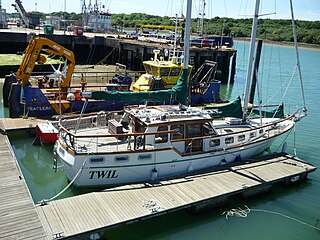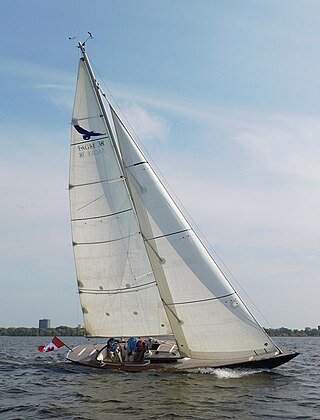Related Research Articles
The Catalina 38 is an American sailboat that was designed by Sparkman & Stephens as a racer-cruiser and first built in 1978.
The Cal 2-25 is an American sailboat that was designed by C. William Lapworth as a cruiser-racer and first built in 1977.
The Leigh 30 is an American sailboat that was designed by Chuck Paine as a cruiser and first built in 1979.
The O'Day 30 is an American sailboat that was designed by C.R. Hunt & Associates as a cruiser and first built in 1977.
The S2 9.2 is an American sailboat that was designed by Arthur Edmunds as a cruiser and first built in 1977.
The Catalina 375 is an American sailboat that was designed by Gerry Douglas as a cruiser and first built in 2008.
The Niagara 31 is a Canadian sailboat that was designed by Germán Frers as a racer-cruiser and first built in 1977.
The Morgan 32 is an American sailboat that was designed by Ted Brewer and Jack Corey and first built in 1980.
The Cape Dory 33 is an American sailboat that was designed by Carl Alberg as cruiser and first built in 1980.
The Freedom 35 is an American sailboat that was designed by David Pedrick as a racer/cruiser and first built in 1993.
The Hinterhoeller F3 is a Canadian sailboat that was designed by Argentine naval architect Germán Frers as a racer-cruiser and first built in 1981.
The Seidelmann 37 is an American sailboat that was designed by Bob Seidelmann as a racer-cruiser and first built in 1980.
The Dickerson 37 is an American sailboat that was designed by George Hazen as a cruiser and first built in 1980.
The Corbin 39 is a Canadian sailboat that was designed by Robert Dufour and Marius Corbin as a global circumnavigation cruiser and first built in 1979.
The Cal 39 Mark II and Cal 39 Mark III are a series of American sailboats that were designed by C. William Lapworth as racer-cruisers to fit the International Offshore Rule and first built in 1978.
The Islander 40 is an American sailboat that was designed by Doug Peterson as a racer-cruiser and first built in 1979.
The Bristol 40 is an American sailboat that was designed by Ted Hood as a racer-cruiser and first built in 1970.

The Nauticat 44 is a Finnish motorsailer sailboat that was designed by Kaj Gustafsson as a cruiser and first built in 1974.

The Eagle 38 is a Dutch sailboat that was designed by Hoek Design as a day sailer and first built in 2019.
The Sun Odyssey 509 is a French sailboat that was designed by Philippe Briand as a cruiser and first built in 2011.
References
- 1 2 3 4 5 6 7 8 9 McArthur, Bruce (2019). "Allmand 31 sailboat specifications and details". sailboatdata.com. Archived from the original on 1 July 2019. Retrieved 7 August 2019.
- ↑ McArthur, Bruce (2019). "Walter Scott". sailboatdata.com. Archived from the original on 26 February 2019. Retrieved 7 August 2019.
- 1 2 3 4 5 6 7 8 9 Sherwood, Richard M.: A Field Guide to Sailboats of North America, Second Edition, pages 376-377. Houghton Mifflin Company, 1994. ISBN 0-395-65239-1
- ↑ McArthur, Bruce (2019). "Allmand Boats Inc. (USA) 1965 - 1985". sailboatdata.com. Archived from the original on 7 August 2019. Retrieved 7 August 2019.
- 1 2 3 Nestor, Gregg (25 January 2011). "Allmand 31: Florida Born and Bound". Cruising World. Archived from the original on 9 October 2017. Retrieved 7 August 2019.
- ↑ "The Allmand Sail 31". Practical Sailor. Archived from the original on 7 August 2019. Retrieved 7 August 2019.